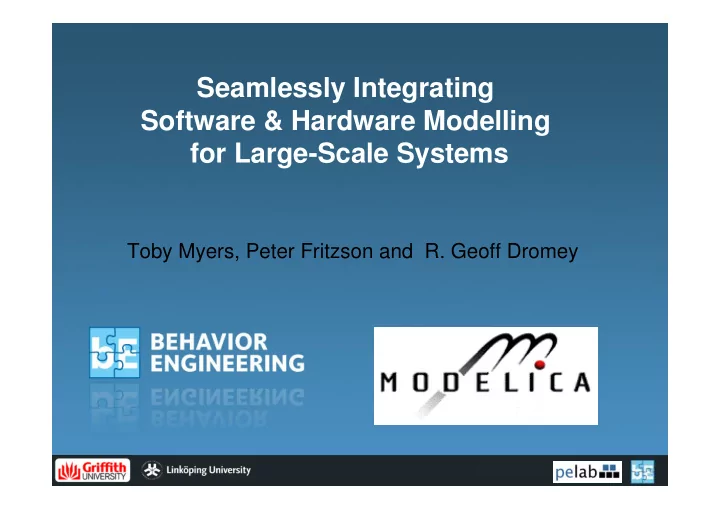

Seamlessly Integrating Software & Hardware Modelling for Large-Scale Systems Toby Myers, Peter Fritzson and R. Geoff Dromey
Overview • The Software-Hardware Integration Problem • A Brief Introduction to Behavior Engineering • Integrating Modelica & BE Models • Case Study: An Automated Train Protection System
Overview • The Software-Hardware Integration Problem • A Brief Introduction to Behavior Engineering • Integrating Modelica & BE Models • Case Study: An Automated Train Protection System
The Software-Hardware Integration Problem • At the early stages of system development, many decisions must be made about how the system will be realised as a combination of Software and Hardware • Requirements of the system at these early stages lack quantified and temporal information so it is hard to make an informed decision • Changing the partioning of software / hardware or how they interact later in development can be time-consuming and costly • There is a potential for errors and incompatibility to be introduced as software/hardware specifications are created independently
Example: Model of Automated Train Protection System An ATP System monitors train position and speed, and may apply brakes if the driver does not react in time
The Software-Hardware Integration Problem Starting from System Requirements
The Software-Hardware Integration Problem �������������������������� ���������� ��������������� �������������� ���������� ������������
The Software-Hardware Integration Problem ���������������������������� ������������� ��������������������� �����������
The Software-Hardware Integration Problem ��������� ������������������������ ����������� ��������� �� ���������
The Software-Hardware Integration Problem !���"�#�����������������������������������$����� ������������� ���������������� ������������ ����������������������� ����������������������������� �������������������������������
Overview • The Software-Hardware Integration Problem • A Brief Introduction to Behavior Engineering • Integrating Modelica & BE Models • Case Study: An Automated Train Protection System
A Brief Introduction to Behavior Engineering Behavior Engineering for Requirements Analysis • 5 Large-scale industry projects – In Defence, Transportation, Banking and Finance – Between 800-1250 requirements • All previously reviewed with respective organisations internal review processes • Defect detection rate approximately 2 to 3 times that of traditional ad-hoc, checklist-based, and scenario-based reading techniques reported in Porter, 1998. Requirements Evaluation Using Behavior Trees Findings from Industry Daniel Powell http://aswec07.cs.latrobe.edu.au/5.zip
Formalization - Requirements Translation Behavior Tree Behavior Tree CAR 1 Functional Requirement ?? Arrives ?? When a car is arrives, GATE GATE 1 1 if the gate is open the car proceeds , ? Open ? ? Closed ? otherwise if the gate is closed, when the driver presses the button CAR DRIVER 1 1 it causes the gate to open [ Proceeds ] ??[[Presses]Button]?? BUTTON 1 [ Pressed ] Formalization – clarification and preservation of intent GATE 1 – strict use of original vocabulary [ Open ] – removes ambiguity, aliases, etc – aids stakeholder validation, understanding – approaches repeatability
A Brief Introduction to Behavior Engineering • Behavior Engineering (BE) acronyms … Behavior Modeling Language (BML) Behavior Modeling Process (BMP) Behavior Trees (BT) Composition Trees (CT) Requirement Behavior Trees Requirement Composition Tree Requirements Translation (RBTs) (RCT) Integrated Behavior Tree Integrated Composition Tree Requirements Integration (IBT) (ICT) Model Behavior Tree Model Composition Tree System Specification (MBT) (MCT) Design Behavior Tree Design Composition Tree System Design (DBT) (DCT)
A Brief Introduction to Behavior Engineering Summary of the Behavior Tree Notation
A Brief Introduction to Behavior Engineering How to translate from a Requirement in Natural Language to an RBT R6. If a caution signal is returned to the ATP controller then the alarm -���� is enabled within the driver’s cab. Furthermore, once the alarm has been enabled, if the speed of the train is not observed to be ��� decreasing then the ATP controller activates the train’s braking .������ system. !���!����������������%���#��� !������������������ &�'���������() ��*+, ������������������ ���������������#��� ����������� ���������'��������� &�������� ������������#��� ��������������������'���������
A Brief Introduction to Behavior Engineering How to translate from a Requirement in Natural Language to an RBT R6. If a caution signal is returned to the ATP controller then the alarm is enabled within the driver’s cab. Furthermore, once the alarm has been enabled, if the speed of the train is not observed to be decreasing then the ATP controller activates the train’s braking system. �!��.���������������#�����#��������������������������� .������������#������������������������ ��������/�����������������)��!����������������������������� �����������'��������/���������������������������������� ���������������������#��,��.��)
A Brief Introduction to Behavior Engineering How to translate from a Requirement in Natural Language to an RBT R6. If a caution signal is returned to the ATP controller then the alarm is enabled within the driver’s cab. Furthermore, once the alarm has been enabled, if the speed of the train is not observed to be decreasing then the ATP controller activates the train’s braking system. �������������������!��.��������������������#���������� ����!����,���������������������)�� �������!��������,���������������������/������!��.���������� ����#���������%���������������������!����) ))����������������������%������������������������#�����
Overview • The Software-Hardware Integration Problem • A Brief Introduction to Behavior Engineering • Integrating Modelica & BE Models • Case Study: An Automated Train Protection System
The Software-Hardware Integration Problem • Integration of Modelica and BE models occurs after the models are compiled into C/C++ source files. • Uses Modelica external functions mapped to C source code which link to the ‘C++’ implementation of the BE model. • The Modelica model is responsible for managing all interactions with the BE model. – When to execute the BE Model – When to send Sensor Information – When to receive Actuator Information
Integrating Modelica & BE Models
Overview • The Software-Hardware Integration Problem • A Brief Introduction to Behavior Engineering • Integrating Modelica & BE Models • Case Study: An Automated Train Protection System
Case Study: An Automated Train Protection System Modelica Model of the ATP System (graphical view)
Recommend
More recommend